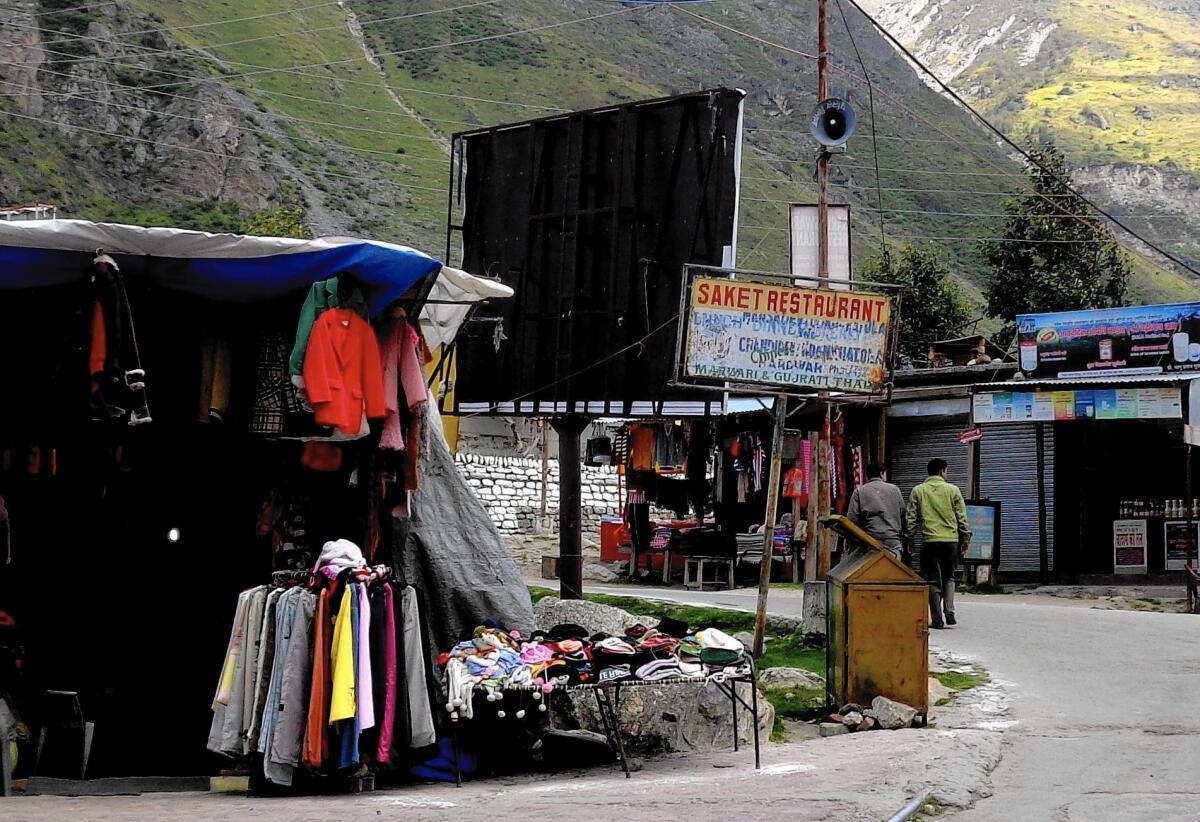After India’s 2013 floods, key Hindu pilgrimage towns deserted

- Share via
Reporting from Badrinath, India — Deserted hotels, barren shops, only the occasional tourist and barely any traffic.
The scene is an unusual one for Badrinath, one of India’s most popular Hindu pilgrimage sites, home to a centuries-old temple that features a black stone idol of the god Vishnu.
The city and surrounding Himalayan pilgrimage circuit are still reeling from last year’s devastating floods in the state of Uttarakhand, which left an estimated 5,700 people dead in the nation’s worst natural disaster since the 2004 Indian Ocean tsunami.
“This is supposed to be that time of the year when we hardly get time to sleep,” said B.S. Chauhan, the elderly, bespectacled receptionist at Hotel Urvashi in Badrinath, nestled amid snowcapped Himalayan peaks.
Normally, he said, “the market would be buzzing with tourists. But last year’s tragedy has totally ruined the business.”
The pilgrimage circuit in the Garhwal region of Uttarakhand consists of four sites — Yamunotri, Gangotri, Kedarnath and Badrinath — whose high season runs roughly from May through October, when milder weather makes the mountainous region and its narrow, winding roads more accessible.
The June 2013 floods swamped large portions of the state, causing landslides that wiped out bridges and roads and trapped about 100,000 travelers in the valleys leading to the pilgrimage sites, some of whom died despite government rescue efforts.
The flooding destroyed parts of the Kedarnath shrine and damaged more than 330 nearby buildings. Officials say reconstruction of the structures is scheduled to begin shortly and will last nearly three years.
Badrinath, more than 130 miles away by road, and the other two pilgrimage sites were spared major physical damage. But because Hindus from across India and worldwide usually visit the four sites together, Chauhan said, the damage in Kedarnath has sapped interest in the other towns as well.
On a recent visit, the main market in Badrinath looked colorful, with vibrant clothes displayed in doorways and ceremonial plates and baubles glittering in shop windows.
Only the customers were missing.
In the frigid weather, shopkeepers wore winter caps and heavy sweaters and stuffed their ears with cotton to ward off the cold. But they sat idle in their shops, killing time by watching television. The yellow-roofed Badrinath temple was all but deserted.
In Gangotri, which saw 443,000 visitors in 2012, only 35,000 had visited as of June, according to a report in India Today magazine.
Officials in Uttarakhand, which derives more than a quarter of its revenue from tourism, say the state has lost as much as $2 billion because many pilgrims have stayed away out of fear. The government body that manages the Badrinath and Kedarnath temples says income from donations has dropped by more than 60%, forcing them to dip into reserves to pay salaries for 325 staff members, the Hindustan Times reported.
The Kedarnath shrine is now closed for the winter, but A.K. Diwedi, a senior state tourism official, said he would encourage visitors to return in 2015.
“Pilgrims can come and pay their respects at the site, but there are limitations and restrictions on the number of visitors because of the destruction around the shrine,” he said.
To encourage visitors, tourism authorities have placed newspaper ads declaring that the pilgrimage is safe. “But it will take time for everything to be back to normal,” Diwedi said.
For the hundreds of families who depend on the pilgrimage economy, the coming winter could prove difficult. Sanjay Bharadwaj, who runs a small grocery store in Rudra Prayag, a town more than 30 miles from Kedarnath, said the floods remained fresh in people’s memory.
“I used to refill my fridge five times a day,” he said. “Now I refill it once in five days.”
For travelers who do visit, there are deals to be struck. At the hotel in Badrinath, a single dormitory-style bed used to go for nearly $3.50 per person. Chauhan, the hotel receptionist, was giving deluxe rooms to some customers for half that price.
Parth M.N. is a special correspondent.
More to Read
Sign up for Essential California
The most important California stories and recommendations in your inbox every morning.
You may occasionally receive promotional content from the Los Angeles Times.








